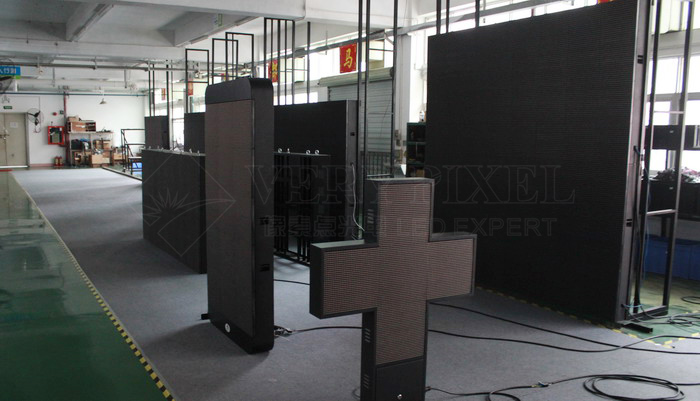Tag: full-color LED display, small pitch LED displays, LED screen display quality 
LED display may encounter different problems during use, in order to reduce such issues, we need take carefully for the following items during display design and producing.

1. Take care of the anti-static.
LED display assembly plant should have good anti-static measures. Such as dedicated anti-static flooring, anti-static soldering iron, anti-static table mat, anti-static ring, anti-static clothing, humidity control, equipment grounding (especially cut legs machine), are all basic requirements, and must use electrostatic analyzer to test the environment periodically.
2. Design the current value.
The nominal current of the LED is 20mA, the generally recommended maximum current must not exceed the 80% of nominal value, especially for small pitch displays, due to poor heat radiation conditions should reduce the current value. According to the experience, because the red, green, and blue light decay rate are not the same, so it’s better to reduce the blue and green LED current value, and finally maintain the consistency of the white balance in the display after prolonged use.
3. The thermal design.
LED working will produce heating, high temperature will speed LED attenuation and effect LED stability, so the PCB thermal design, and cabinet ventilation design will affect the performance of LED display.
4. The driving circuit design.
The driver IC arrangement in the drive circuit board of display module will also affect the brightness of the LED. If driver IC transmission distance is too far in the PCB, then the transmission path voltage drop is too much, resulting in a lower brightness because the normal operating voltage of the LED is lost during transmission. We often found the LED around module brightness is lower than the middle, and this is the reason. Therefore, to ensure the consistency of the brightness of the display, it is necessary to design a uniform driver circuit maps.
5. Mix LED.
The LED with same color but different brightness need to be mixed, or discrete insert LED lights in PCB, to ensure the color consistency of the entire screen. If there is a problem in this process, there will be the part area brightness is inconsistent, directly influence the effect of the LED screen.
6. Make sure the DIP LED is Perpendicular to the PCB board.
For DIP LED, ensure that the LED is perpendicular to the PCB board before soldering. Any deviation will affect the brightness consistency, and result color blocks.
7. Wave soldering temperature and time.
To ensure the screen quality, must strictly control the reasonable wave welding temperature and time, it is recommended that: preheating temperature is 100 ° C ± 5 ° C, the maximum does not exceed 120 ° C, and the preheating temperature must rise smoothly, soldering temperature is 245 degree ± 5 degree, and welding time is no more than three seconds, the PCB should not vibration or shock after soldering, until it reinstate normal temperature. The temperature of the wave soldering machine need to be checked regularly, this is determined by the characteristics of LED, overheating or temperature fluctuations will directly damage the LED or cause the LED quality risks, especially for the small size as 3mm round and oval LED.
8. Welding control.
More than 50% blind LED in display are caused by failure welding, such as LED pin failure welding, IC pin false Welding, signal pin lost welding and so on. Those problems need improve producing process and strengthen the quality inspection. Vibration testing before shipping is a good testing method.
Verypixel Outdoor LED Display

Page address: http://www.verypixel.com/blog/full_color_LED_display_precautions.html